Halloween is almost here, so it seems like an appropriate time to round up a list of some of the most disturbing, unsettling and just outright frightening albums ever made. Put these on at your Halloween party and your guests might run away in terror. Or, perhaps, you might get some unexpected and uninvited guests joining you without warning. Either way, if your October isn’t feeling creepy enough just yet, put any of these terrifying albums on and, once their menacing melodies worm their way into your head, you’ll be certain to wake up in a cold sweat. Listen—if you dare.
This list originally was published in 2011 and has been updated and expanded.
Note: When you buy something through our affiliate links, Treble receives a commission. All albums included are chosen by our editors and contributors.
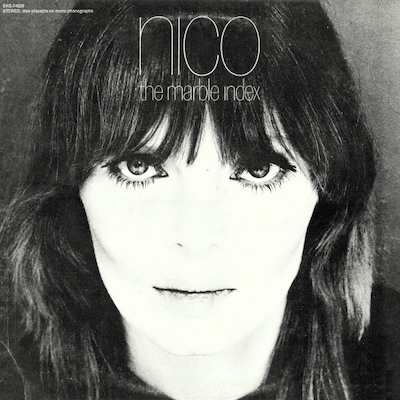
Nico – The Marble Index
On The Velvet Underground & Nico and Chelsea Girl, German singer Nico had an atypically magnetic charm about her. On The Marble Index, however, she stands at the center of a bleak and disorienting swirl of gothic harmonium drones and just plain out there sounds, most of which are provided by onetime bandmate and fellow aficionado of the abstract and weird, John Cale. “Lawns of Dawn,” when its parts are separated, might not seem so ominous. But when its ethereal windchimes, wheezing harmonium, nebulous synth tones and distorted background screech (okay, that’s pretty disturbing on its own) come together beneath Nico’s sea shanty-like vocal melody, it adds up to something you’d never want to hear with the lights out. Even more intense still is “Facing the Wind,” which sets a weirdly jaunty piano against the ever-present harmonium drones, whose erratic changes in volume mimic the effect of wind blowing through a haunted woods, while the arrhythmic percussion is just plain wrong, described by different critics and listeners as everything from the sound of someone rapping on a coffin lid to that of being buried alive.
Listen: Spotify

White Noise – An Electrical Storm
One of the strangest albums to be born of the psychedelic end of the 1960s, White Noise’s An Electrical Storm featured members of the BBC Radiophonic Workshop (Delia Derbyshire, Brian Hodgson) who specialized in crafting disorienting and strange electronic soundscapes, which translated into some peculiar and fascinating psych pop songs. An Electric Storm is at times whimsical (“Firebird,” “Here Come the Fleas”), frequently trippy, but often veers into moments of chaos and darkness, achieving a climax of mind-bending fear with the 11-minute exorcism of “The Visitation” and the sinister, occult ritual of “An Electric Storm in Hell,” which is punctuated with sharp stabs of electronics and horrifying screams. More than 50 years later it still seems to cause spirits to come crawling out of the attic.
Listen: Spotify

Comus – First Utterance
One of the earliest bands to truly earn the description of “freak folk,” Comus delivered a stunningly dark opus of psychedelic folk with their debut album First Utterance, whose beauty and horror are often intertwined. As influential on metal bands like Opeth as they were on folk and rock music, Comus took their intricate progressive folk compositions to strange and sometimes horrific places, whether through a kind of eerie, supernatural atmosphere (“The Herald”) or through depictions of violence and brutality (“Drip Drip”). That the members of Comus are such proficient musicians only makes the experience all the more palpable and at times nauseating, crafting terror with proficiency and a singular vision.
Listen/Buy: Spotify | Amazon (vinyl)

Suicide – Suicide
I’ll level with you: This album is here for one reason, specifically: “Frankie Teardrop.” Comprising an entire third of the running time of Suicide’s debut album, the 10-minute dirge of violence and paranoia turns a story of a desperate factory worker who loses his job and then turns to a horrific act of violence in its aftermath, Alan Vega belting out some of the most blood-curdling screams in recorded history. (Which in turn inspired Bruce Springsteen on Nebraska five years later.) That the other seven songs on the album are minimalist punk and ’50s-style rock and roll through distorted organ and seemingly plucked from a David Lynch soundtrack only adds to the general sense of unease throughout what’s an otherwise great, weird, iconoclastic punk rock record.
Listen/Buy: Spotify | Amazon (vinyl)

Throbbing Gristle – D.O.A.: The Third and Final Report
One of the first fully realized industrial albums—Throbbing Gristle having coined the term themselves—D.O.A.: The Third and Final Report is a musical masterpiece that often feels like a free-for-all. Featuring pieces written individually by the experimental group’s four members amid a series of tracks that range from harsh electronic noise (“I.B.M.”) to raucous synth-punk (“Hit by a Rock”) and a series of menacing answering machine messages (“Death Threats”), D.O.A. is an exercise in extremes. Sometimes they’re pleasant and even kind of pretty, as on the kosmische pulses of “AB/7A,” but most of the time they’re antagonistic and unsettling, as with the harsh grinding of “Walls of Sound,” the dark ambient wooziness of “E-Coli,” or the juxtaposition of eerie drones against found-sound trash talk on “Valley of the Shadow of Death.” Though nothing here, or maybe on any of these albums, is as vile and harrowing as “Hamburger Lady,” a work of nightmarish performance art that’s quietly intense enough to cause extreme physical reaction.
Listen/Buy: Bandcamp | Merchbar (vinyl)

Various Artists – The Shining
Horror as a cinematic genre has historically been fertile ground for some of the most creative scoring through the years, such as Goblin’s Suspiria or John Carpenter’s Halloween. The Shining is a fascinating exception in that much of the score that Wendy Carlos and Rachel Elkind created for the film went unused in the final product, with much of the film instead being soundtracked by dissonant orchestral works by Béla Bártok, Györgi Lygeti and Krzysztof Penderecki. Though it’s technically a compilation of existing works, other than Carlos’ ominous reworking of “Dies Irae,” there are few scores nearly as effective in capturing the sheer hatchet’s edge terror, be it through the demon choir of “Utrenja” or the atonal violence of “Polymorphia.”
Listen/Buy: Archive
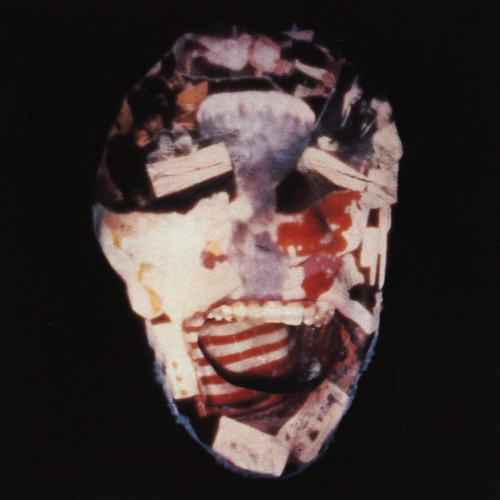
This Heat – Deceit
UK post-punk trio This Heat laid down their share of hypnotic, Krautrock-inspired grooves in their day, notably on epic single “Health and Efficiency,” proto-techno standout “24 Track Loop,” as well as a handful of the more accessible moments on groundbreaking second album Deceit. But while a slightly off-kilter lullaby like “Sleep” and a punk rocker like “S.P.Q.R.” can lull the listener into a false sense of security, much of the very same album creates a menacing and disorienting atmosphere that’s consistently intriguing and perpetually alarming. “Independence” sets the text of the Declaration of Independence against a darkly moody post-punk backdrop, “Paper Hats” descends into a fierce stew of dissonance and screaming, and the chanting that opens up “A New Kind of Water” is like a cult ritual. Yet sometimes the band is at their creepiest when most melodic, as on “Cenotaph,” the melody of which is simply eerie. And then there’s “Radio Prague,” a humming, tapping tape-music nightmare of disembodied voices cutting in and out, and “Hi Baku Shyo,” a post-apocalyptic mixture of sounds and atmosphere that replicates a post-nuclear wasteland.

Nurse With Wound – Homotopy to Marie
Where to start with this one? Perhaps I should mention the erratic clang of cymbals that run throughout the duration of Homotopy to Marie. Then there’s the militant marching at the opening of “The Schmurz.” Add to that the little girl complaining of a funny smell, the moans of agony, sometimes with added effects to sound just that scarier, as well as the low ambient drones. The ghostly and unexpected old-time piano samples only deepen the atmosphere of inexplicable terror. The sudden swells of cacophonous howling and piercing shrieks make it turn violent. And the crunching metallic noises that open the record serve as a merciless bludgeon. I could go on, but the gist is that Homotopy to Marie is one of the weirdest, most terrifying recordings ever produced.
Listen/Buy: Bandcamp
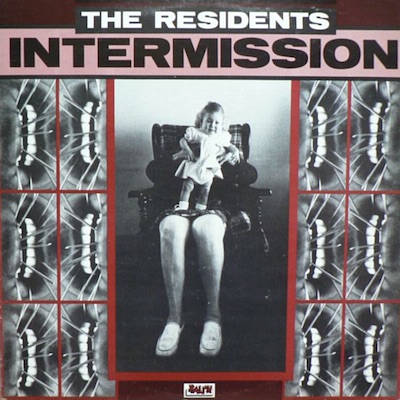
The Residents – Intermission
Depending on the listener, just about any recording by The Residents could be deemed their creepiest: The musique concrête of the satirical Eskimo, the chaotic weirdness of Meet the Residents, the fucked-up tonalities of Duck Stab. Intermission is only 25 minutes long but contains some of their most bizarre and mysterious pieces—three of its five tracks are labeled as intermissions, and fittingly sound like music for the elevator ride to the underworld. Where most of their albums offer the more insidious experience of making you feel like you’re slowly losing your mind, this is the recording of The Residents that most overtly captures the sound of horror.
Listen: Spotify
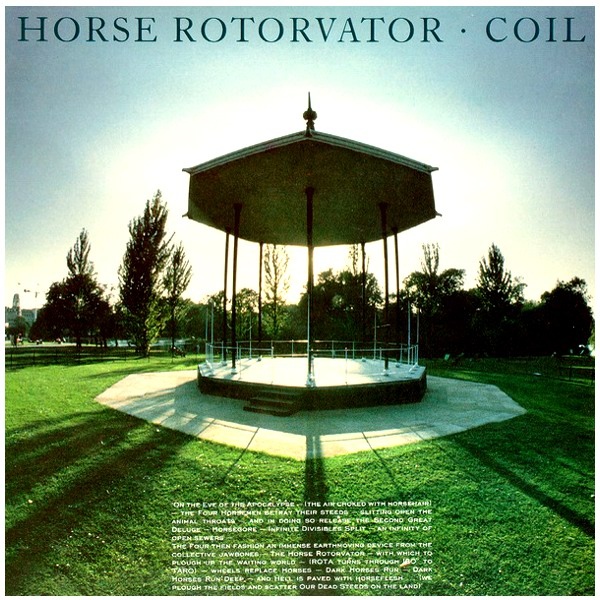
Coil – Horse Rotorvator
John Balance had a reputation for making some truly bizarre and troubling sounds in his lifetime, and Horse Rotorvator is perhaps the best showcase of the broadest of his creepy musical palette. A bridge between the abstract industrial of Einsturzende Neubauten or Nurse With Wound with the more accessible acts like Ministry or Nine Inch Nails (Trent Reznor was massively influenced by Coil), Horse Rotorvator presents its fright factor early with its title, which describes a farming tool made of a horse’s skull, used to till the earth after Armageddon. OK then! Fun stuff. But then there’s the music, which runs from tuneful haunts such as “Slur” (featuring guest vocals by Soft Cell’s Marc Almond), to carnivalesque hallucinations as “Circles of Mania” and the ambient descent into hell, “Blood from the Air.” Even when the melodies approach anything resembling pop music, nothing feels safe here.
Listen: Apple Music
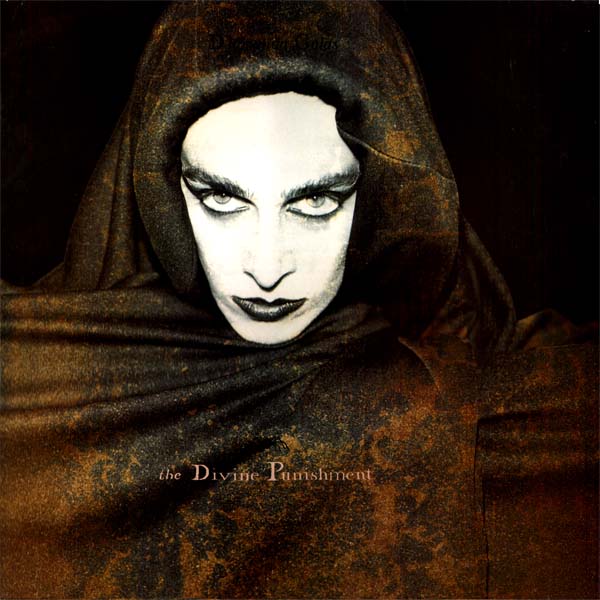
Diamanda Galás – The Divine Punishment
A singular performer and one of the most powerful vocalists in what could only very, very loosely be described as pop music, Diamanda Galás possesses a stunning vocal range that she puts to use through music that often feels as if it’s tapping into supernatural phenomena. Her 1986 album The Divine Punishment is her greatest studio work, part of the Masque of the Red Death trilogy of albums whose compositions are both a commentary on the AIDS epidemic and feature references to biblical scripture. And while The Divine Punishment is a stunning feat of musical and vocal performance, it’s as harrowing as music gets, juxtaposing what feels like an occult ceremony against gently eerie strains of neoclassical darkwave and menacing industrial harshness—all guided by a vocal powerhouse that sounds like she’s capable of channeling something we can neither see nor understand.
Listen/Buy: Bandcamp | Merchbar (vinyl)
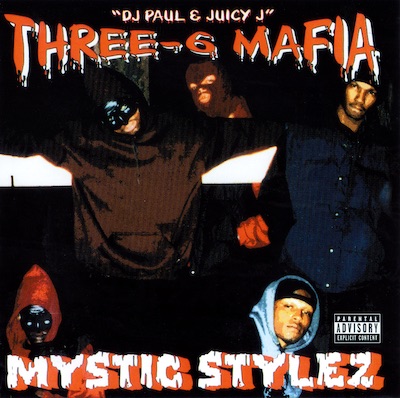
Three 6 Mafia – Mystic Stylez
As gangsta rap reached peak popularity in the ’90s, a group out of Memphis took hip-hop to more sinister heights. With a name that referenced the mark of the beast and grim lo-fi production that wore their love of horror on their sleeves (and occasionally sounded like a snuff film), Three 6 Mafia independently released their debut Mystic Stylez to slow-burning interest nationwide. Depicted on the album’s cover in masks—and with Koopsta Knicca on a cross—Three 6 Mafia presented themselves as not just intimidating but actually terrifying, delivering a narratives of violent splatter along with hauling corpses and practicing voodoo. Though its menacing crackle and occult-obsessed aesthetic, the album became an underground classic, its stature growing via dedicated cult following on the strength of songs like booming opener “Break Da Law ’95” and a rare break from mayhem in the steamy “Da Summa.” It’s a masterful exercise in audio horror.
Listen/Buy: Spotify | Merchbar (vinyl)
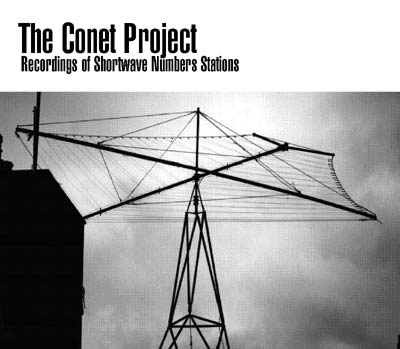
The Conet Project – Recordings of Shortwave Numbers Stations
The Conet Project is not so much an album of songs as it is a four-plus-hour archive of field recordings from shortwave radio transmission. Many of them are actually recordings from spy stations during World War II, and the decaying, static-ridden condition of the sounds contained therein results in a creepy experience through and through. Some of these tracks have been sampled by the likes of Stereolab and Wilco (the repetition of “yankee… hotel… foxtrot” should sound familiar to some), but without the added melodic accompaniment, these recordings are eerie at their tamest, and downright apocalyptic sounding at their most intense. The juxtaposition of ice-cream truck music against counting in Swedish on “The Swedish Rhapsody” is creepy enough, but in the final minute, the recording warbles a bit, and the once detached voice briefly grows more horrific. “Gong Station/Chimes” is disturbing in its stark, distorted melody. And “The Backwards Music Station”… well, it’s pretty damn eerie.
Listen: Archive
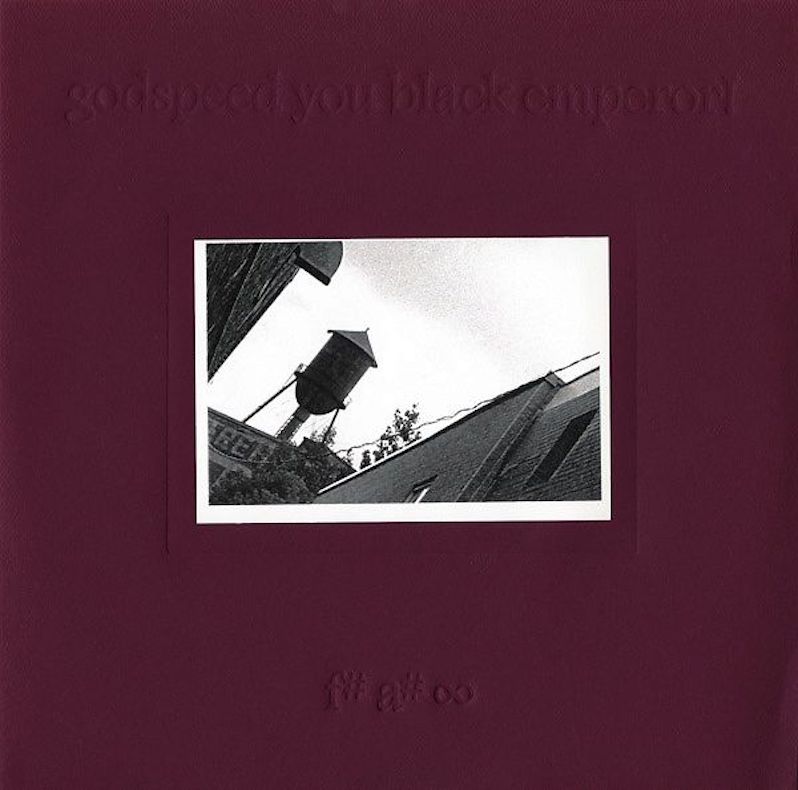
Godspeed You! Black Emperor – F#A# ∞
“The car’s on fire and there’s no driver at the wheel, and the sewers are all muddied with a thousand lonely suicides—and a dark wind blows...” Within the first minute of their debut album, F#A# ∞, Montreal collective Godspeed You! Black Emperor make clear that it’s not a casual or soothing listening experience. Though primarily an instrumental work, its opening track “The Dead Flag Blues” begins with a narrative of an apocalyptic future both horrifying and sad, which sets the stage for 34 minutes of bleak, cinematic grandeur. Entangled in moments of beauty and stillness, F#A# ∞ depicts nothing which could be mistaken for hopeful, each of its two lengthy compositions scoring a landscape leveled by humanity’s worst impulses. It’s no coincidence that “East Hastings” was used in zombie film 28 Days Later, or for that matter a viral video of an abandoned, post-Katrina amusement park in Louisiana; this is the sound of the endtimes.
Listen/Buy: Bandcamp | Turntable Lab (vinyl)

Current 93 – I Have a Special Plan for This World
It’s not a coincidence that a significant portion of the albums here come from the world of industrial music, its antagonistic performance art aspect lending itself to drawing on fear and terror in ways most mainstream music never would. By 2000, Current 93’s David Tibet had transitioned deeper into neofolk, delivering his most widely acclaimed release with 1996’s All the Pretty Little Horses, which featured guest vocals from Nick Cave. But on the single-track 2000 EP I Have a Special Plan for This World, Tibet returned to the dark abstractions of his earlier industrial recordings with a lengthy spoken-word track featuring lyrics from a Thomas Ligotti poem, slowly descending into bleak nihilism as its drones creep ever louder and hanging heavy with dread, the sounds of rewinding tapes, distorted vocal repetitions and the general feeling that the world is closing in on you. “All I heard were the faintest echoes reminding me: There are no others/There are no others.”
Listen/Buy: Bandcamp
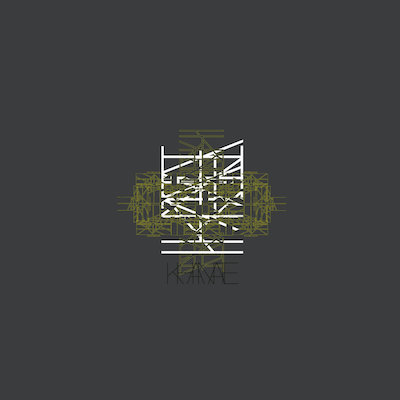
Khanate – Khanate
Khanate isn’t an ideal band to listen to before bedtime if you plan on having a restful sleep. Their weaponized feedback and punishing array of dense and noisy, slow-moving guitar riffs—coupled with Alan Dubin’s demented vocals—tend to lend themselves to psychic torment and horrific imagery. Their self-titled 2001 album is both their best album and their most upsetting, fraught with lengthy exercises in aural agony and deeply disturbing subject matter. After you hear Dubin screech “say it, say you’ll give me your skin,” you might never sleep again.
Listen/Buy: Bandcamp | Merchbar (vinyl)

Sunn O))) – Black One
Sunn O)))’s music can be soothing, spiritual, even beautiful. Black One isn’t necessarily any of these things, certainly not on an overall scale. Where an album like Monoliths and Dimensions showcases the broader scale of the drone-doom duo’s capabilities as composers, Black One focuses in on their commitment to conjuring up an unseen darkness. The incorporation of more ornate gothic textures in “Candle Goat” pierce Stephen O’Malley and Greg Anderson’s overwhelmingly dense frequencies with old-school horror tropes, “Cursed Realms (of the Winterdemons)” sounds like field recordings from Hell, and “Bathory Erszebet” is a slow-burn slab of menace made all the more claustrophobic through its urban legend of Malefic recording its vocals inside of a locked coffin.

Scott Walker – The Drift
In the 1960s, Scott Walker released some of the greatest orchestral pop records ever pressed to vinyl on his run from Scott to Scott 4. But after that, he grew ever more eccentric and reclusive, reappearing once every decade or so with a record far weirder than anything he had ever done before. This pattern reached a jaw-dropping climax with The Drift, a lengthy and dissonant piece of art that falls somewhere between the modern classical pieces of Krzystof Penderecki and Gyorgi Lygeti, and the abrasive darkwave of early highlights from the 4AD catalog. It’s not an easy listen, though it is a breathtaking one. Each song is a majestic piece of harrowing orchestration and unsettling imagery, from “Jesse,” which is a fictional account of Elvis Presley’s stillborn brother, to “Clara,” which was inspired by September 11th. At one point Walker pounds a side of beef as percussion. It’s a work of highly troubling genius.
Listen/Buy: Spotify | Merchbar (vinyl)

Portishead – Third
Portishead’s music, though dark in an accessible, ethereal sense, never really approached anything truly scary. That is, until they released Third. Doing away almost entirely with the idea of “trip-hop,” sonic mastermind Geoff Barrow began pursuing darker, denser psychedelic sounds, inspired heavily by the Silver Apples. But his take on throbbing, pulsing psych is considerably more disturbing. Amid a handful of prettier tunes, such as single “The Rip,” the group primarily set their compass to uglier, more abrasive textures which, ironically, comprise a stunningly beautiful, if often terrifying whole. A voice in Portuguese begins the album with an ominous warning that translates to “Beware the number three.” The atmospheric “Small” erupts into a trip through hell via hallucinogens. Closing track “Threads” perhaps coincidentally shares the title of a particularly intense made-for-TV depiction of life after nuclear attack, but as it fades out, leaving only a repetitive moan of an evil synthesizer that lingers like a phantom limb.
Listen/Buy: Spotify | Merchbar (vinyl)

Ben Frost – By the Throat
In hindsight it’s not all that surprising that Ben Frost—much like his contemporaries The Haxan Cloak and Colin Stetson—would eventually get into film and TV scoring, given how evocative his sonic landscapes are, depicting a scorched earth without visuals or even words. His music is tense and uneasy even when inert, but it’s also constantly shifting, unlocking some new danger or trapdoor, baying coyotes and growling wolves. Listening to By the Throat feels like walking through a post-apocalyptic landscape with no light other than what’s been set ablaze, synthesizers like broken glass, cello like rusted sawblades, voices phasing in and out if only to remind you they’re not quite human. Though 2014’s A U R O R A is perhaps a heavier and noisier album in some respects, By the Throat is far more unsettling, a listening experience on a razor’s edge.
Listen/Buy: Bandcamp
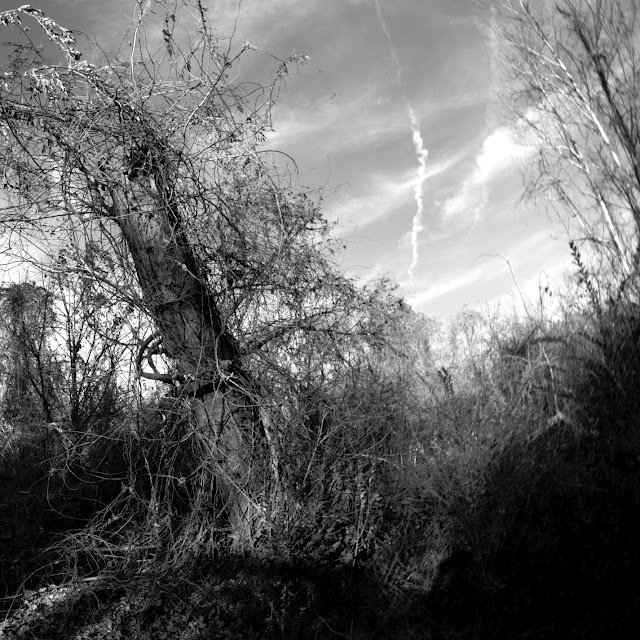
Harvey Milk – A Small Turn of Human Kindness
I’ve never considered much metal to be all that scary, though the storm sound effects in “Raining Blood” are certainly ominous, as well as the general vibe of more of the depressive, lo-fi black metal. But Georgia sludge/noise rock outfit Harvey Milk—who have a great sense of humor, it should be noted—managed to make one of the most nightmarish sludge albums they could muster on A Small Turn of Human Kindness. It’s not an immediate fright, simply because it’s a slow moving churn of a thing, but as the plot thickens, and the darkness harbored by its two central figures becomes clearer, there’s a moment of harrowing clarity that puts the whole thing into terrifying perspective. That songs like “I Alone Got Up and Left” manage to turn nauseatingly intense just makes it that much more powerful.
Listen/Buy: Bandcamp

Tim Hecker – Virgins
Tim Hecker draws beauty from sounds that are distressed and broken, distorted and fragmented. The sounds on his 2013 album Virgins are, in places, some of his most conventionally beautiful, made in collaboration with a small ensemble of musicians performing live in a room. In fact, there’s a track titled “Live Room,” and it’s here—after a handful of pieces that more explicitly showcase Hecker’s eerie spectrality—where the phantoms begin creeping in through the cracks in the wall. Horror-movie piano keys descend like they’re tumbling down a staircase, sound warbles and wavers, and uneasy drone rises up from beneath. Hecker’s compositions and creepy artwork for the album evoke both the Virgin Mary as well as the images of tortured prisoners at Abu Ghraib. Virgins juxtaposes supernatural beauty with a more physical kind of horror, visions of the sublime against primal fear.

Pharmakon – Bestial Burden
There are plenty of common fears: Death, enclosed spaces, public speaking, and so on. Though it’s sometimes hard to imagine anything more terrifying than being trapped inside your own failing anatomy. Pharmakon’s Margaret Chardiet composed Bestial Burden after undergoing emergency surgery to have an organ removed, the experience horrifying enough to warrant a death-industrial opus surrounding the experience. Chardiet stacks each side of the album with an intro comprising wheezing, coughing and breathing, the second more traumatic to listen to than the first, as if to draw the listener into the hospital bed she once occupied, segueing into moments of oozing drones and piercing high-end shrieks, punctuated with screams and percussive crashes. Its greatest moment is the title track, a frightening hallucination that could be likened to Pharmakon’s own “Hamburger Lady,” at once musical and menacing, her spoken-word refrains of “I don’t belong here…” both disorienting and panic-inducing. All four of Pharmakon’s albums are scary as a matter of operating procedure; Bestial Burden rises to the top because it’s the most realistic kind of horror.
Listen/Buy: Bandcamp | Merchbar (vinyl)

Xiu Xiu – Plays the Music of Twin Peaks
The world of David Lynch’s Twin Peaks is already steeped in terror and mystery, which grows even more unsettling when Angelo Badalamenti’s music is filtered through the lens of avant garde indie outfit Xiu Xiu. Released three years after the group’s tribute to Nina Simone, Plays the Music of Twin Peaks is strangely one of the band’s most accessible sets of music while likewise being the Xiu Xiu album that carries the greatest degree of nightmarish grandeur. The group treat Julee Cruise’s “Into the Night” to a more hellish degree of gothic drone, set the edges of “Audrey’s Dance” ablaze and splatter noise all over the Fire Walk With Me highlight “Pink Room.” Where much of Xiu Xiu’s music is more outwardly abrasive and confrontational, Plays the Music of Twin Peaks is more eerily atmospheric, a set of distorted relics that feel more haunted than agitated.
Listen/Buy: Bandcamp | Turntable Lab (vinyl)

Lingua Ignota – Caligula
Kristin Hayter retired her Lingua Ignota alias earlier this year, transitioning into the similarly unsettling and uncannily beautiful Saved!, her debut album as Reverend Kristin Michael Hayter. But in the project’s lifespan, she released four full-length recordings of divine retribution and gothic hellfire. The loudest and most thunderous of her four LPs, 2019’s Caligula is both cinematic and explosive, capturing a ritualistic recital of choral hellfire informed by noise, darkwave, metal and the darkest edges of the traditional hymn book. Caligula is not always an easy listen, erupting into passages that seethe with righteous anger and feel as if they’ve opened up the gates to hell. It’s sometimes the quieter moments that leave the heaviest pit in one’s stomach: the ghostly intro to “BUTCHER OF THE WORLD,” the hypnotic opening of “FAITHFUL SERVANT FRIEND OF CHRIST,” or the moment of calm that precedes the massive climax of “SPITE ALONE HOLDS ME ALOFT.” When all hell breaks loose, there’s no turning back.
Listen/Buy: Bandcamp
Treble is supported by its patrons. Become a member of our Patreon, get access to subscriber benefits, and help an independent media outlet continue delivering articles like these.


